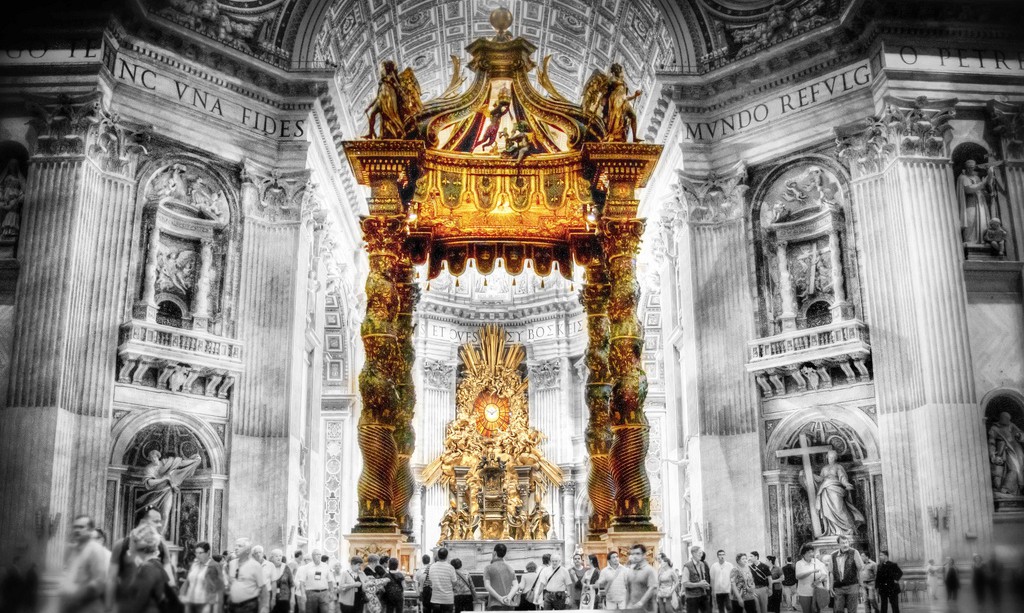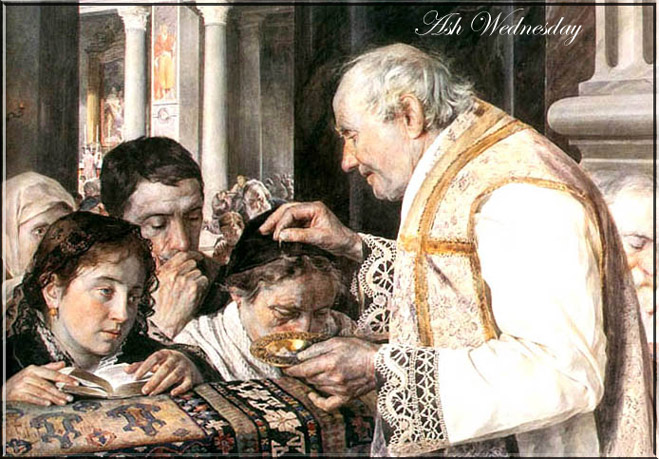
Fr. Goffine’s instruction for the First Sunday of Lent:
INVOCABIT – This Sunday is called Invocabit, because the Introit of the Mass begins with this word, which is taken from the ninetieth psalm, wherein we are urged to confidence in God, who willingly hears the prayer of the penitent:
INTROIT – He shall call upon me, and I will hear him; I will deliver him, and glorify him; I will fill him with length of days. (Ps. 90:15-16) He that dwelleth in the aid of the Most high shall abide under the protection of the God of heaven. (Ps. 90:1) Glory be to the Father, etc.
COLLECT – O God who dost purify Thy Church by the yearly fast of Lent; grant to Thy household that what we strive to obtain from Thee by abstinence, by good works we may secure. Through our Lord, etc.
EPISTLE – (II Cor. 6:1-10) Brethren, we exhort you that you receive not the grace of God in vain. For he saith: In an acceptable time have I heard thee, and in the day of salvation have I helped thee. Behold, now is the acceptable time; behold, now, is the day of salvation. Giving no offence to any man, that our ministry be not blamed: but in all things let us exhibit ourselves as the ministers of God; in much patience, in tribulations, in necessities, in distresses, in stripes, in prisons, in seditions, in labors, in watchings, in fastings, in chastity, in knowledge, in long-suffering, in sweetness, in the Holy Ghost, in charity unfeigned, in the word of truth, in the power of God, by the armor of justice on the right hand, and on the left, by honor and dishonor, by evil report, and good report; as deceivers, and yet true; as unknown, and yet known; as dying, and behold we live; as chastised, and not killed; as sorrowful, yet always rejoicing; as needy, yet enriching many; as having nothing, and possessing all things.
EXPLANATION – The Church very appropriately reads on this day this epistle of St. Paul, in which he exhorts the Christians to make use of the time of grace. A special time of grace is Lent, in which everything invites to conversion and penance, a time, therefore, in which God is ready to make rich bestowal of His graces. St. Anselm says, those do not use the grace who do not cooperate. Let us, therefore, follow St. Paul’s exhortation, and earnestly practice those virtues he places before us, and especially those of temperance, patience, chastity, liberality, love of God and of our neighbor. Let us arm ourselves with the arms of justice at the right and the left, that is, let us strive to be humble in prosperity and in adversity, confident of God’s help. Let us never be led from the path of virtue, by mockery, contempt, nor by persecution, torments, or death.
ASPIRATION – Grant, O Jesus, that we may always faithfully cooperate with Thy graces, and employ well the time Thou hast again given for our salvation.
GOSPEL – (Matt. 4:1-11) At that time, Jesus was led by the Spirit into the desert, to be tempted by the devil. And when he had fasted forty days and forty nights, afterwards he was hungry. And the tempter coming, said to him: If thou be the Son of God, command that these stones be made bread. Who answered and said: It is written: Not in bread alone doth man live, but in every word that proceedeth from the mouth of God.
Then the devil took him up into the holy city, and set him upon the pinnacle of the temple, and said to him: If thou be the Son of God, cast thyself down; for it is written: He hath given his angels charge over thee, and in their hands shall they bear thee up, lest perhaps thou dash thy foot against a stone. Jesus said to him: It is written again: Thou shall not tempt the Lord thy God.
Again the devil took him up into a very high mountain, and showed him all the kingdoms of the world, and the glory of them; and said to him: All these will I give thee, if, falling down, thou wilt adore me. Then Jesus said to him: Begone, Satan, for it is written, The Lord thy God shall thou adore, and him only shall thou serve. Then the devil left him; and behold, angels came, and ministered to him.
Instruction
I. Christ went into the desert by the inspiration of the Holy Ghost to prepare by fasting and prayer, for His mission, and to endure the temptations of Satan, that, as St. Paul says, He might be one tempted in all things such as we are, without sin, and so become for us a High Priest who knew how to have compassion on our infirmities, (Heb. 4:15) and to show us by His own example, how we should, armed with the word of God, as with a sword, overcome the tempter. (Eph. 6:17)—Let us, therefore, courageously follow Christ to the combat against all temptations, with His assistance it will not be hard to conquer them. He has certainly taught us to overcome the hardest ones: the lust of the eyes, of the flesh, and the pride of life, and if we overcome these, it will be easy to conquer the rest.
II. If Christ, the only Son of God, permitted Himself to be tempted by Satan, even to be taken up on a high mountain, and to the pinnacle of the temple, it should not appear strange to us, that we are assailed by many temptations, or that we should find in the lives of so many saints that the evil spirit tormented them by various images of terror and vexation. This we find in the history of the pious Job, where we also find at the same time, that the evil spirit cannot harm a hair of our head without God’s permission.
III. From the coming of the angels to minister to Christ, after He had conquered Satan, we see that all who bravely resist temptations, will enjoy the assistance and consolations of the heavenly spirits.
Instruction on temptation
“To be tempted by the devil.” (Matt. 4:1)
What is a temptation?
A temptation is either a trial for instruction and exercise in virtue, or a deception and incitement to sin. In the first sense, God tempts man; in the second, he is tempted by the devil, the world or bad people, and the flesh, by evil thoughts, feelings, words, or work.
By what are we principally tempted?
By our own evil concupiscence and inclination to sin which adhere to us through original sin, (Jam. 1:14) on account of which it is said, that the flesh lusteth against the spirit. (Gal. 5:17)
Does the devil also tempt us?
He does, and is therefore called, in this day’s gospel, the tempter. St. Peter teaches us this, having himself experienced it: Be sober and watch: because your adversary the devil, as a roaring-lion, goeth about, seeking whom he may devour. (I Peter 5:8) Not all temptations are to be ascribed to the devil, however, they often come from our own corrupt nature, our own incautiousness, or looseness of our senses, by which we expose ourselves to the danger of falling into sin.
How does the devil tempt us to sin?
In a twofold manner: He incites the concupiscence of man to those sins to which he sees him inclined, and then seeks to blind and confuse his imagination, so that he neither reflects, nor properly sees the temporal injury, disgrace, and derision, nor the shamefulness of sin and its eternal punishment. Thus the devil seduced Eve, our first mother, and thus he tempted Christ, with whom he could not, of course, succeed, for He was incapable of sin. He tempts bad people to persecute us, or to try us by their wicked vanities, as he did by the friends of Job.
Can the devil force us to evil?
He cannot; “for as a chained dog,” says St. Augustine, “can bite none but those who go near him, so the devil cannot harm with his temptations those who do not consent to them. Like the dog he can bark at you, but cannot bite you against your will.” Not by force but by persuasion Satan strives to injure, he does not force our consent, but entreats it. Seek, therefore, to subdue your passions and your senses, especially your eyes, and you will either remain free from all temptations, or easily overcome them.
Does God also tempt us?
God does indeed tempt us, but not to sin, as St. James expressly teaches. (Jam. 1:13) God either Himself proves us by sufferings and adversities, or He permits the temptations of the devil or evil-minded people to give us opportunity to practice the virtues of love, patience, obedience, etc. Thus He said to the Jews through Moses: The Lord your God trieth you, that it may appear whether you love him with all your heart, and with all your soul, or no. (Deut. 13:3)
Does God permit us to be tempted by man also?
He does, and for the same reasons. Thus He permitted the chaste Joseph to be tempted by Putiphar’s wife; (Gen. 34:7) Job by his wife and his friends. (Job 2:9) But He never permits us to be tempted beyond our strength, but gives us always sufficient grace to overcome and even to derive benefit from the temptation. (I Cor. 10:13)
Are temptations pernicious and bad?
No; they are useful and necessary, rather. “Hard is the fight,” St. Bernard writes, “but meritorious, for although it is accompanied by suffering, it is followed by the crown;”
(Apoc. 3:12) and Origen says. (Libr. Num.) “As meat becomes corrupt without salt, so does the soul without temptations.” Temptations, then, are only injurious when consent is given, and we suffer ourselves to be overcome by them.
When do we consent to temptations?
When we knowingly and willingly decide to do the evil to which we are tempted; as long as we resist we commit no sin.
What are the best means of overcoming temptations?
Humility; for thus answered St. Anthony, when he saw the whole earth covered with snares, and was asked “Who will escape?” “The humble;” he who knows his own frailty, distrusts himself, and relies only on God who resists the proud and gives His grace to the humble; (Dam. 4:6) the fervent invocation of the Mother of God, of our holy guardian angels and patron saints; the pronouncing of the holy name of Jesus, making the sign of the cross, sprinkling holy water; the remembrance of the presence of God who knows our most secret thoughts, and before whom we are indeed ashamed to think or do that which would cause us shame in the presence of an honorable person; frequent meditation on death, hell, and eternal joys; fleeing from all those persons by whom, and places in which we are generally tempted; fervent prayers, especially ejaculations, as:
“Lord, save me, lest I perish! Lord, hasten to help me!” finally, the sincere acknowledgment of our temptations at the tribunal of penance, which is a remedy especially recommended by pious spiritual teachers.
PRAYER O Lord Jesus! who spent forty days in the desert without food or drink, and didst permit Thy self to be tempted by the evil spirit, give me, I beseech Thee by that holy fast, the grace to combat, during this holy season of Lent, under Thy protection, against intemperance, and to resist the suggestions of Satan that I may win the crown of eternal life. Amen.








